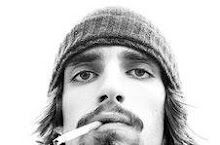Just down the street from Rudy Rotter's Museum of Sculpture in Manitowac is the studio of renowned photographers, J. Shimon & J. Lindemann. While not exactly outsiders to the world of art, Julie and Johnie bring to each of their photographs a certain intuition worth mentioning.
Our class met in their studio where Julie showed us around and answered some of our questions. Due to time restraints, our class had to run before I could think of any questions worth asking. Upon leaving I asked Julie if I could send her over some questions for an interview. Below is the result.

http://www.shimonlindemann.com/
What was it like starting out in a small town in Wisconsin? I think it would be interesting to live and work in a big city, but personally I'd prefer to set up shop in the middle of nowhere.
We started our projects in Madison and Milwaukee mainly and felt like we had gotten a bit of a start working and showing by the time we bought our studio building in Manitowoc. We had friends and contacts when we came here and always made a point to do outreach. We were intensely focused and wanting to be photographers. The Internet did not exist as it does today in the beginning but we had a fax and FedEx and that helped.
I read that you both moved to New York but returned to Wisconsin after a year. What was this experience like, and why did you return?
We moved from New York to Milwaukee where we worked at the Milwaukee Art Museum and made editorial portraits for Milwaukee Magazine, Art Muscle and the Shepherd. We dug being around what was quirky and familiar and all the great cheap thrift stores and funky people. We ran out of money in New York when Julie's student loans came due and our rent increased from $400 a month to $1600. Johnie didn't care for being in the big city and that made us less determined to stay there.
How did you deal with competition starting out? Is it just a matter of waiting for the leading photographer to keel over and then take their place?
We just did what we did and tried to show our pictures to whoever would look at them. Some people liked how we approached projects and others didn't at all. We found an audience.
What kind of education did you guys receive on art and photography? Was it instrumental in your success as working artists?
Johnie has a degree in sculpture and painting and Julie in journalism. We were in school at a time that teachers didn't teach. It was very hands off, not like today. Same for grad school. In fact this experience informs how we teach. We are very rigorous and demanding of our students! Not laid back like our professors. We learned a lot by talking to older photographers, meeting artists and going to museums, galleries and reading magazines. We still do all of this and feel completely unsuccessful and woefully inadequate. But sometimes we have fun and meet amazing people and that sometimes seems more important than so-called success. Not sure on any of this today!
What kind of commissions do you guys receive? Which ones are consistently paying the bills?
We are full-time professors at Lawrence University in Appleton teaching photography and digital processes. 10-15 years ago we were shooting for the New York Times, Fortune, People and others. We also worked for local industry shooting products for packaging. That was lucrative and enabled us to build up our personal work and upgrade our cameras. We always taught, shot for magazines, did some product work and pursued our own projects and wrote grants to fund them. Juggling it all was exciting and sometimes jarring.
What is it like having your work published and recognized in galleries and museums? How did you get started with this?
It's a long road. We wanted to make photographs all the time so about 25 years ago we started showing our pictures around to gallery owners and curators. Then we just kept doing it.

Why shoot film in such a digital age? How do you feel about digital photographs?
Film has a specific appearance and it works for what we're trying to do. We like the connection to the continuum and the history of the medium. Julie shoots snapshots with a Canon G10 and uploads them to flickr and Johnie makes rock music videos that he posts on YouTube in addition to the platinum-palladium prints that we make and exhibit. Artists should use whatever medium suits a specific project and enables communication with whatever audience they have in mind.
Besides going digital, has the photography market changed since you started? Where do you see it going in the future?
There's much less call for original photographs for commercial purposes. Photos are used and reused rather than commissioned for specific purposes. Working with light sensitive materials or analog processes will become totally an artist's domain. Young artists might consider taking advantage of online communities by doing blogs or sharing their work in some way. The problem is cutting through the clutter. There are so many images out there that some photographers, like Joachim Schimd http://schmid.wordpress.com have given up making images and spend their energy curating images from flickr to make new thematic projects.
Is there any advice you would give to an aspiring photographer who is about to graduate?
This is a hard one because we're in an exciting and maybe scary time of change. We are thinking about it a lot too. Hopefully if you are determined, focused and engaged, something will reveal itself. Judging from our friends who have had some success, we can only say that it takes time and a lot of dedicated work before it starts making sense.

No comments:
Post a Comment